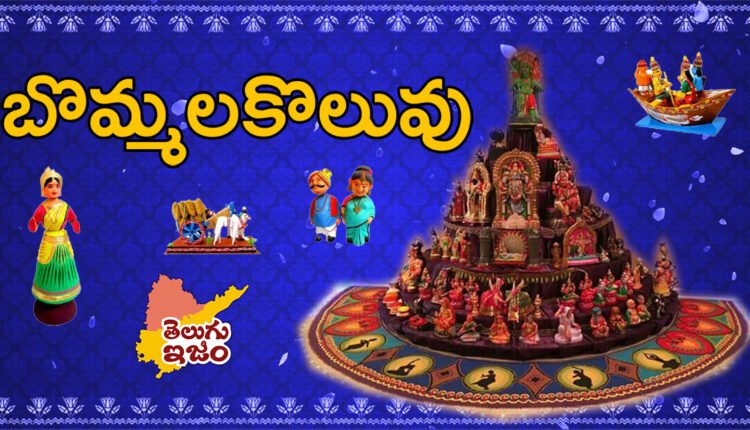Bommala Koluvu : Holds Significant Cultural & Religious Importance
Bommala Koluvu : In Andhra Pradesh, families with female children traditionally display dolls for nine days during Dussehra and three days during Sankranti. The specific celebration may vary depending on household customs, with some observing Dasara and others focusing on Sankranti. The arrangement and types of dolls may also vary based on regional differences. During the ten-day festival of Dussehra Navratri, this joyful doll festival is celebrated to commemorate the triumph of Goddess Durga. The doll display typically consists of nine steps, each adorned differently based on artistic vision, financial means, and available resources.
The origin of the doll display custom can be traced back to the last fifteen days of the Bhadrapada month, known as Mahalaya Paksha or the war and ancestral worship period. It is believed that during these days, a great battle took place between the gods and demons. As the gods faced defeat and sought refuge, they invoked the divine powers of various deities, such as Durga, Saraswati, Lakshmi, and weapon deities. The worship continued faithfully for several years until one Vijayadasami day when Goddess Jagan Mata was pleased with the devotion and bestowed bows and different types of weapons upon the men. Women were gifted idols of adorned goddesses.
Inspired and empowered by the blessings of the goddess, men enthusiastically fought against the demons. Meanwhile, the women gathered the gifted idols, worshiped them, and contributed their pious energy to aid in the victory. This day came to be known as Vijayadashami. Women began displaying the idols they received and worshiping them as dolls during Dussehra, and this tradition has continued through generations.
Bommala Koluvu & Arrangements
The doll display follows Gods and goddesses’ figurines are placed on the steps, symbolizing sattva guna or purity. Figures related to worldly life are placed on the lower steps, representing tamas guna or darkness. The central part of the display features figures like kings, queens, and warriors, symbolizing Kshatriya dharma or the duty of warriors.
At the top step, a Kalash (urn) represents Goddess Karuna or compassion. Overcoming these three qualities is believed to invite the grace of the goddess. The steps are covered with a white cloth, and the arrangement of dolls may differ slightly based on regional variations.
During the nine-day festival, daily rituals such as lighting lamps, offering incense, and reciting Lalita Sahasranama and Lakshmi Ashtottaram, are performed. Each day, a young girl and a married woman (Suasini) are offered food, tambulam (betel leaves), decorative items, and clothes.
In the evenings, prayers are conducted, and it is believed that calling children and giving them turmeric, kumkum, tambulam, and dakshina (a form of monetary offering) brings blessings and the grace of the goddess. Saffron, exchanged among women, symbolizes prosperity, while ashtagandham (eight types of fragrant substances) and turmeric signify good health. During these days, needlework is avoided as it is said that Devi performed penance on the tip of a needle to defeat Mahishasura.
The arrangement and display of dolls are reimagined each year, with new dolls added to the collection. While clay and porcelain dolls were the norms in the past, plastic dolls and Barbie dolls are now also available. The doll display may include various gods, such as Ganesha, Rama, Krishna, Lakshmi, Saraswati, and Parvati, as well as freedom fighter figurines, wedding figurines, comic figures, and more.
Certain figures like Panchangam Brahma, Pedda Muttaiduva, Pachari Kottu Komati, a mother with a child, and a cow are considered essential. Other figures, including animals, birds, fruits, and trees, are placed to complement the main figurines. Over time, figurines representing national leaders, ancient buildings, modes of transportation, and vehicles have also found their place in the display.
These colorful figurines, puppets, and patriotic symbols, which are usually stored away throughout the year, are brought out for Sankranti in some places and Dussehra in others. In some areas, small children, referred to as Raju and Rani, live around the doll displays. Additionally, it is still customary in some places to gift toy sets to the houses of recently married couples or as part of dowry traditions.
Temples also commonly participate in the doll display tradition during Dussehra and Navratri. Mathura Meenakshi’s temple, for example, showcases various goddess idols during Navratri. Therefore, the inclusion of dolls in temples can be considered an age-old tradition.
Similarly, for Sankranti, the dolls are arranged to honor Sankranthi Purusha, who is believed to descend to Earth during this time to rule over all beings. The specific dolls and arrangements during Sankranti follow similar patterns as the Dussehra doll display.
The Sankranthi doll display, known as Bommala Koluvu, begins on the day of Bhogi and concludes on Kanuma day, spanning three days. Offerings of turmeric, saffron, tambulam, and muttaiduvas are made on Sankranti day, and the image of Godadevi, who is revered during Dhanurmasam, is included in the tambulam. Specially crafted Sankuramayya dolls are gifted to agricultural communities.
It is worth noting that the tradition of making and selling dolls, including other toys, has become less prominent in the streets compared to the past. Opening a toy box and unveiling the dolls has its own charm and is celebrated with pujas, arati, incense, and joyful singing of songs with children.
Many such celebrations are now cherished memories for Telugu people. Special wooden boxes were traditionally used to store and hide the dolls, often wrapped in old silk cloths.
In conclusion, the doll display tradition during Dussehra and Sankranti in Andhra Pradesh holds significant cultural and religious importance. It not only celebrates the victory of good over evil but also serves as a means to invoke the blessings and grace of the deities. The arrangement and types of dolls may vary, but the spirit of devotion, joy, and familial celebration remain central to the custom.
Also Read : https://telugutraditions.com/wp-admin/post.php?post=859&action=edit

